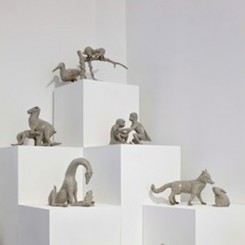This authorial reading is, of course, indispensable to our understanding of Stranger than Paradise in that it gives us an insight into the thinking behind the making of the work. However, I would like to suggest here the possibility of another inter-textual/inter-cultural line of interpretation supplementing that which Yang himself has put forward; one that places the imaginary scene represented by Stranger than Paradise not simply as an extension to theDecameron, but also as an alternative to the trajectory of established Biblical narrative.

Yang Jiechang,”Stranger than Paradise – Mountain Top,” ca. 30 seconds in loop, 2010/2011 with video GONG, 2011.
In the story of Noah’s ark―versions of which appear in chapters 6-9 of the book of Genesis as well as in the surahs “Hud” and “Al-Mu’minoon” of the Qur’an, and whose origins can be traced back to an earlier Babylonian source―God looks down upon the wickedness of mankind and, sorely disappointed by his creation, decides to send a great flood to cleanse the earth. God also sees that among the whole of mankind Noah alone “remains righteous in his generation”. He therefore instructs Noah to save himself and his family by building an immense seagoing ark capable of housing “two of every sort [of animal]…male and female … everything on the dry land in whose nostrils was the breath of life”. When Noah’s family and all of the animals are safely on board and the door to the ark firmly closed, God then releases the fountains of the deep and opens up the floodgates of heaven until after six months the highest mountains are covered by water to a depth of fifteen cubits and all of the people and animals (apart from fish, marine mammals and amphibians) outside the ark are destroyed.

“Stranger than Paradise – Mountain Top,” installation of 200 ceramic sculptures realized from 100 unique
After seven months the waters of the great flood reach their highest point and over the next seven months gradually subside, eventually allowing the ark to come aground on the slopes of Mount Ararat. During the fourteenth month after the beginning of the great flood, Noah, his family and the animals then proceed to leave the ark and repopulate the earth. Upon leaving the ark, Noah raises a sacrifice to God who, for his own part, bestows on Noah and his sons the right to kill and eat the meat of animals that have been judged to be clean (the distinction between clean and unclean animals having been established, according to Judaic tradition, as the animals entered into the ark) while forbidding the eating of meat that has not been drained entirely of its blood. God also proclaims that blood will henceforth be sacred and that unlawful killing forbidden, stating that “For your lifeblood I will require a reckoning: from every beast I will require it and from man…Whoever sheds the blood of man, by man shall his blood be shed, for God made man in his own image.” In addition to all of which, God establishes a covenant with Noah, his family and the animals stating that he will never again send a great flood to destroy the earth, accepting that “the intention of man’s heart is evil from his youth”. God then places a rainbow in the sky as “the sign of the covenant that I have established between me and all flesh that is on the earth”. As such, the story of Noah’s ark has been interpreted within a Christian scholarly context as a symbolic precursor to the later coming of Christ, whose crucifixion and taking on of all human sins is intended to obviate the need for further acts of sacrificial violence as part of divine worship.



